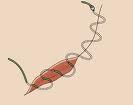
This skin suturing method provides good strength during the healing process and a better-looking scar long-term. Despite these advantages, there are some very typical short-term issues that will occur in almost all patients with these types of sutures at this skin level. And the culprit is exactly what provides the advantages…buried dissolveable sutures.
While dissolveable sutures do go away with time, some longer than others based on their chemical composition, a different reaction can occur at the skin level. Most dissolveable sutures are tested and their resorption rates and characteristics studied at deeper tissue levels, usually muscle. The resorption process occurs through a combination of water absorption and a natural inflammatory and breakdown process. In deeper tissue levels, this process is never seen and it occurs uneventfully. In the skin, however, this process can often become unmasked and evident to the patient.

These skin suture reactions can be very disturbing to patients for several reasons. First, they are unexpected and will make the patient think that something is wrong and their surgery site is infected. Over the years in my Indianapolis plastic surgery practice, I have gotten many calls about these problems. Secondly, they occur at a time when patients understandably feel that they should be getting better and they are out of any ‘danger.’ And lastly because they affect the suture line, it is believed that the scar may end up worse.
These benign but disturbing localized suture reactions do not usually cause any long-term wound healing or scar issues. They are either self-resolving or can be easily cured by removal of the offending suture(s). Antibiotics are rarely needed to make them get better, suture removal is always curative. Some patients will have none, other just one or two, and rarely someone will have numerous suture extrusions. It is important for patents to realize that that stitch reactions are normal and are the result of skin suturing techniques and how the resorbable suture process naturally occurs.
Dr. Barry Eppley
Indianapolis, Indiana


